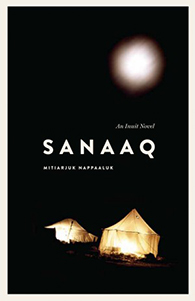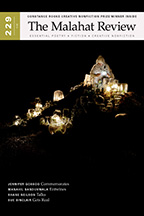Reviews
Fiction Review by June Halliday
Mitiarjuk Nappaaluk, Sanaaq: An Inuit Novel, transliterated and translated from Inuktitut to French by Bernard Saladin d’Anglure, translated from French by Peter Frost (Winnipeg: University of Manitoba, 2014). Paperbound, 227 pp., $24.95.
 Sanaaq is subtitled as “An Inuit Novel.” The literal definition of Inuit is “human beings,” therefore, there is something for us all in the achingly human story of Sanaaq. Mitiarjuk Nappaaluk invites us on an exotically northern forty-eight-chapter journey through time and place. The novel is a fictional, internal ethnography by an Inuit woman—written over the span of twenty years due to health and geographic barriers—recording the day-to-day interactions, culture, spirituality, and survival of Sanaaq, a young, widowed, single mother and her family living in rural northern Quebec. The timeline is chronological, set roughly in the 1950s, yet non-linear (as many Indigenous people believe time flows) and spans many dramatic events: births, deaths, violence, infidelity, the influx of Qallunaat (literally translated as “big eyebrows”), or white men and the religions that followed.
Sanaaq is subtitled as “An Inuit Novel.” The literal definition of Inuit is “human beings,” therefore, there is something for us all in the achingly human story of Sanaaq. Mitiarjuk Nappaaluk invites us on an exotically northern forty-eight-chapter journey through time and place. The novel is a fictional, internal ethnography by an Inuit woman—written over the span of twenty years due to health and geographic barriers—recording the day-to-day interactions, culture, spirituality, and survival of Sanaaq, a young, widowed, single mother and her family living in rural northern Quebec. The timeline is chronological, set roughly in the 1950s, yet non-linear (as many Indigenous people believe time flows) and spans many dramatic events: births, deaths, violence, infidelity, the influx of Qallunaat (literally translated as “big eyebrows”), or white men and the religions that followed.
The Foreword is the story of how the story of Sanaaq came to be. Written by Bernard Saladin d’Anglure, who translated Sanaaq from Inuktitut to French in 2002 (fifty years after it was written), it provides literary, historical, and cultural context, and the additional reading recommendations include works by the author, translator, and other critical writing on Inuit literature. Understanding the process and evolution of the novel and Nappaaluk’s writings ultimately enriches the reading; however, I recommend saving the Foreword for after as Nappaaluk’s creativity and storytelling stands solidly on its own two feet.
Sanaaq reads like a screenplay, due in large part to dynamic dialogue. Almost every page of the novel contains dialogue that creates a rapid immediacy to the narrative. One can’t help but think of films like Atanarjuat: The Fast Runner (the 2001 Inuktitut-language film directed by Inuit filmmaker Zacharias Kunuk). The film, like the novel, is strange and disjointed, yet provides an intimate view of a unique culture with its harsh, icy landscape and the atuarniq (north wind) as an ever-present character. Reflecting the landscape, there is a brusqueness to the language and an efficiency of time. The language is active and present. For example, the entire action of sewing a skirt is contained within one line of dialogue: “My skirt has been ripped apart on this side…I’ll have to sew it together first. Hand me a needle and some sinew. There we are, all done! Here’s your needle.”
In Chapter 17 “Sanaaq Gives Birth to a Son,” we learn that Sanaaq is pregnant and in the very next sentence she gives birth. Other actions, such as building an igloo or hunting on the sinaa (edge of an ice floe) are given step-by-step instructions over a longer passage of time. Time, landscape, and language are interconnected with an urgency for survival. “Just then, the two snowy owls dive-bombed the dogs again. One even stripped some fur off one of them.”
There is an abrupt masculinity to the prose and, at first, I wondered if the dual male translations—translated to English by Peter Frost in 2014—may have veered away from the feminine. According to d’Anglure, Nappaaluk’s early experiences included learning both “women’s traditional work” and “the secrets of hunting and other male tasks” due to her father’s poor health. Perhaps neither, perhaps both, affected the writing, but the nuances and specificity of the Inuktitut language are unique to the people and the place. For example, an uuttuq is a “seal stretched out on an ice floe…basking in the sun.” The rich Arctic imagery—fleshed out by the glossary—is the connective tissue between the story and the reader.
The beginning of the novel reads much like a survival guide. Traditional stories and myth are woven into the narrative later in the book, showing both the passage of time and the growth of the writer. The teachings are a resource for Inuit people who continue to hunt and live in the North. An Elder explains, “It’s known that animals with only skin on their bones have parasites. As do very skinny birds.” My favourite story shares teachings through demonstration. The first boots Qumaq—Sanaaq’s daughter—sewed were gifted to her maternal grandmother who was also her midwife at birth: “Ningiukuluk found the boots to be very beautiful because they were the work of her arnaliaq [female she helped to deliver], even though they were not at all well made.” A reminder to us all to slow down and honour the process of growth and maturation.
The Qallunaat brought welcome change: bars of soap, un-welcome change: sending sick children away for hopeful healing, and uncertainty: conflicting religious views. Chapter 38 is devoted to “Sanaaq’s Flight” with her son who became ill after falling into the frigid water. Sanaaq fled with her son in order to keep him from being sent away. This resulted in her husband, Qalingu, beating her and Sanaaq herself had to be sent away for medical treatment. Full of shame for what he had done, Qalingu left home to work “among the Qallunaat” in order to provide for his family. “The First Medical Examination,” chapter 45, demonstrates an unfolding realization of the Qallunaat and “…some of the unpleasant things…being done to them.”
Reading this story now, knowing what we know about the path of history, we already know “the ending” far beyond the novel’s final chapter. Through Sanaaq’s eyes, we see one of the final regions in Canada to experience contact and colonization. We witness the precursors to divisions among families, abuse, residential schools, the introduction of a monetary system, and the departure away from self-sufficiency. Through fiction, we witness the real impact of the arrival of missionaries by boat and, later, the Inuit agents by plane.
Nappaaluk was a prolific writer, authoring more than twenty books in her seventy-six years. Her work is relatively unknown outside of the Inuit community, but I hope this translation will open her work to a wider audience and encourage future translations. This Inuit novel is an Elder’s gift from the young woman who wrote over the span of her lifetime, to educate and inspire those who have long passed, those of us in this present moment, and those not yet born.
—June Halliday









